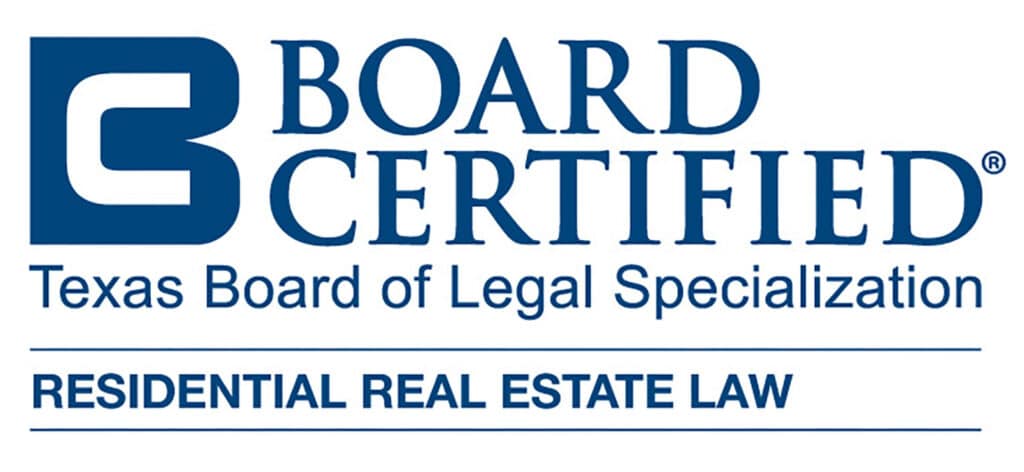 in Residential Real Estate Law" width="1024" height="472" />
in Residential Real Estate Law" width="1024" height="472" />Real estate property is often owned by two or more people at the same time. However, by default, jointly owned property does NOT automatically include a Right of Survivorship in Texas. This differs from many other states. A Right of Survivorship Agreement states what happens to the property if one of the owners should pass away. When joint owners of real estate property have this agreement properly prepared, signed in front of a notary and filed in the county records, if one owner dies, the property becomes the sole property of the other owner. Immediately and automatically. In many states, the property may transfer to the remaining co-owner automatically without a separate agreement. But this is not the case in Texas. Good to know: If you own Texas real estate jointly with one or more individuals, it is important to have a survivorship agreement in place. With this agreement, you will ensure that the deceased owner’s interest in the property automatically transfers to the surviving owner.
 in Residential Real Estate Law" width="1024" height="472" />
in Residential Real Estate Law" width="1024" height="472" />

It is common for spouses to co-own their home. Both names are on the deed. Property may also be owned by a parent and child at the same time. Siblings, such as a brother and sister, may both own the same property. Many owners assume that when one of the property owners dies, the other owner will automatically become the sole owner of the real estate property. Unfortunately, this is not true.
Note: If joint owners do not have a Right of Survivorship Deed or Agreement, a deceased property owner’s interest in the property may pass to their heirs rather than to the surviving property owner. The deceased owner’s interest in the property does NOT automatically transfer to the surviving property owner.
Good to know: Co-owners of property can sign a Right of Survivorship Deed when they buy the property or they can sign a Survivorship Agreement at any time after they buy the property. The only requirement is that they co-own the property AND agree to the Survivorship Agreement.
If you have a Joint Tenant With Right of Survivorship agreement, keep in mind that your heirs will not receive or inherit the real estate property described in the agreement when you die. The property will instead pass to your co-owner. Even if you have a Will, once you sign the Survivorship Agreement, the property will pass to you co-owner and not to any devisee you have named in your Will. Good to know: Generally, when a property owner dies without a Last Will and Testament, the interest owned by the deceased owner passes to his or her heirs-at-law. A deceased person’s heirs-at-law are defined by Texas law. The heir is not always the spouse of the deceased owner, and it is not always the co-owner. Without a properly prepared Survivorship Agreement, after the death of your co-owner, you may find yourself owning your home with a person you do not like or who you may not even know.

For further information about heirs-at-law, there is an excellent chart by the Honorable Judge Guy Herman, Travis County Probate Court No. 1. https://www.traviscountytx.gov/images/probate/Docs/DnD_diagrams.pdf Without a Survivorship Agreement, if the deceased owner has a properly prepared, signed and probated Last Will and Testament, the co-owned interest in the property will pass to the person named in the Will to receive the property. This person is usually called the Devisee. The Probate process usually requires you to hire a lawyer to file an Application to Probate a Will. The application needs to be filed in the correct probate court, which is usually the probate court for the county where the deceased person lived, not necessarily where the property is located. After the application is filed, the probate clerk may schedule a hearing where you will need to go to court and prove the Will is really the Last Will and Testament of the deceased person. If the judge agrees, the Will will be “admitted to probate.” The executor of the Will will then need to sign an Executor’s Deed transferring the property to the devisee. The cost to probate a Will could be $3,000 or more. The process may take several months, depending on the court’s schedule. On the other hand, if the co-owners of the property want to avoid the time and expense of probate AND still pick the person they want to receive the property, they can simply sign a Survivorship Agreement.
If you buy property just in your name and you later get married or just want to add your spouse or significant other, you can sign a General Warranty Deed to add your spouse AND, at the same time, sign a Survivorship Agreement. By doing this, you and your spouse will co-own the property together as Joint Tenants with Right of Survivorship. Good to know: BEWARE – Just adding your spouse or another person to the title to your home does not mean that the new co-owner will inherit the property if you die. You need a General Warranty Deed with Survivorship Agreement. This may also be known as a Survivorship Deed. Our fee for both documents is $195 total. Sometimes a parent may want to add one of his or her children to the title to the home so that “nothing happens” when the parent dies. Unfortunately, something will happen. Adding a name to your title is not enough. The parent’s other heirs will still inherit a 50% interest in the property. In other words, the other children will own 50% of the property even if this was not the intention of the parent. In this case, the parent needs a Survivorship Agreement if he or she wants ONE child to inherit a property. A General Warranty Deed with Survivorship Agreement is the document the parent/owner needs.
In many states property co-owners may simply write “Joint Tenants with Right of Survivorship” on their deed. Furthermore, in many states, owners might simply write the abbreviation “JTWROS” on the property deed by their names. In other states, by doing so, it creates a legally binding Joint Tenancy With Right Of Survivorship. However, this is not the case in Texas.
Note: In Texas, you must have a written agreement for Right of Survivorship.
A written JTWROS agreement can be signed by co-owners at any time before the death of one of the owners. If you sign and file it when you first purchase the property the county filing fees may be less, but you can still file it at any time. The county recording fees are usually $30-$40. The document should clearly state the names and address of all owners of the property and legally describe the property. It needs to be signed by all owners in front of any notary. The owners do not need to sign at the same time or at the same place. One owner can be out of state. No problem. Just be sure to sign in front of a notary.
Good to know: The county clerk requires all documents filed in the property records to be notarized. If a document is not properly notarized the clerk will not file it. Also, if the document is not the original, the clerk will not file it. Once the Survivorship Agreement is properly prepared and signed by all owners in front of a notary, the original signed document should be mailed or taken to the county clerk’s recording department for filing. The clerk will take the original, file stamp it, scan it, and give it or send it back to you. This makes it a public record.
Note: When one of the co-owner passes away, an Affidavit of Death filed in the county records is used to verify that one owner is deceased and that the surviving owner now owns 100% of the property.
Co-owners with Joint Tenancy with Right of Survivorship can be ANY co-owners. Although a surviving owner may often be a spouse or someone related to the deceased owner. However, the only requirement is that the surviving owner co-owned the property with the deceased owner, AND the two owners signed a Survivorship Agreement. Examples of a surviving co-owner might be:
After the owners sign the Survivorship Agreement, they will legally be Joint Tenants with Right of Survivorship.
The co-owners can sell the property at any time. A Survivorship Agreement does not prevent the owners from selling.
Note: A Survivorship Agreement will only apply to the specific real estate described in the Survivorship Agreement. The agreement will not apply to any of your other properties or assets.

When a married couple who co-owns property has children from a prior relationship, we strongly advise that both owners sign a Survivorship Agreement in Texas.
Good to know: Without this legal agreement, if one spouse dies, his or her interest in the property may pass to his or her estate rather than to the surviving spouse. All persons identified as the heirs will own 50% of the property along with the living owner.
If this happens, you may find yourself co-owning your property with your deceased spouse’s child or children from a previous marriage. In order to prevent this from happening, you must have a Survivorship Agreement.
For example, parents who both own and live in their home sign a Survivorship Agreement so that the property will pass to the surviving owner without the cost of probate. Additionally, they can sign a Transfer on Death Deed to further name the person they want to receive the home after both parents/owners pass.
If you have a Transfer on Death Deed in place, it will prevent your heirs from incurring the expense and time of a probate proceeding or the need for an Affidavit of Heirship.